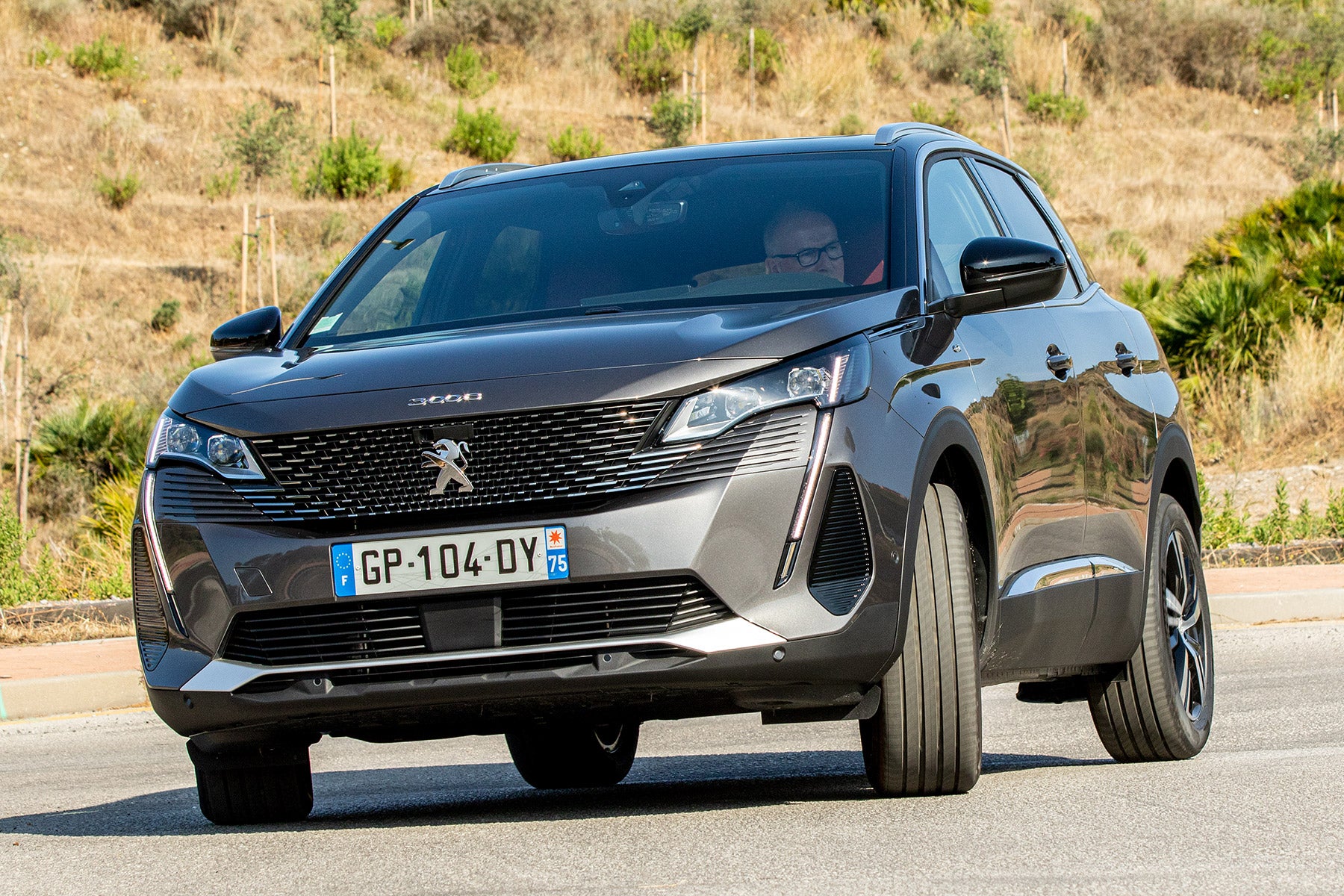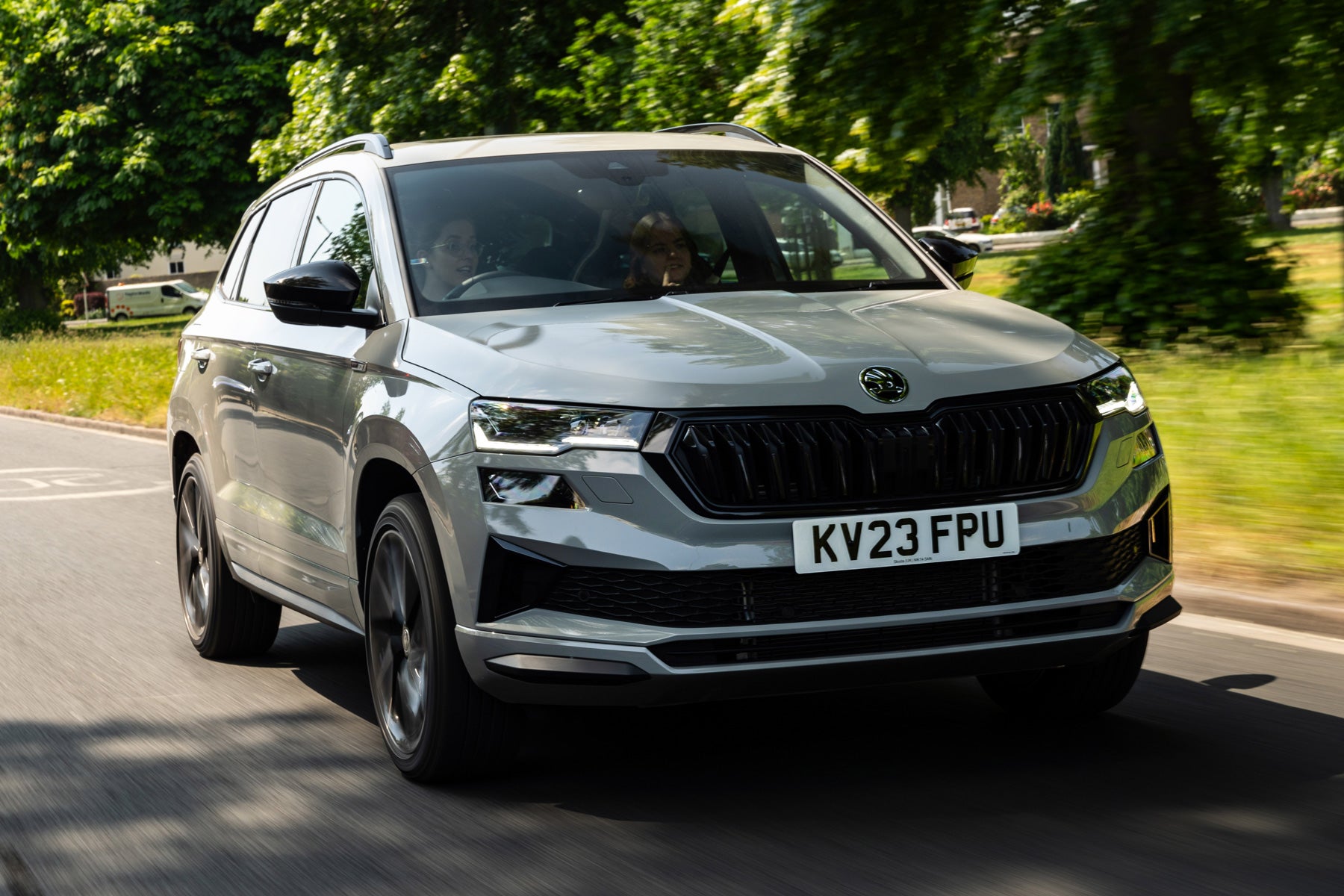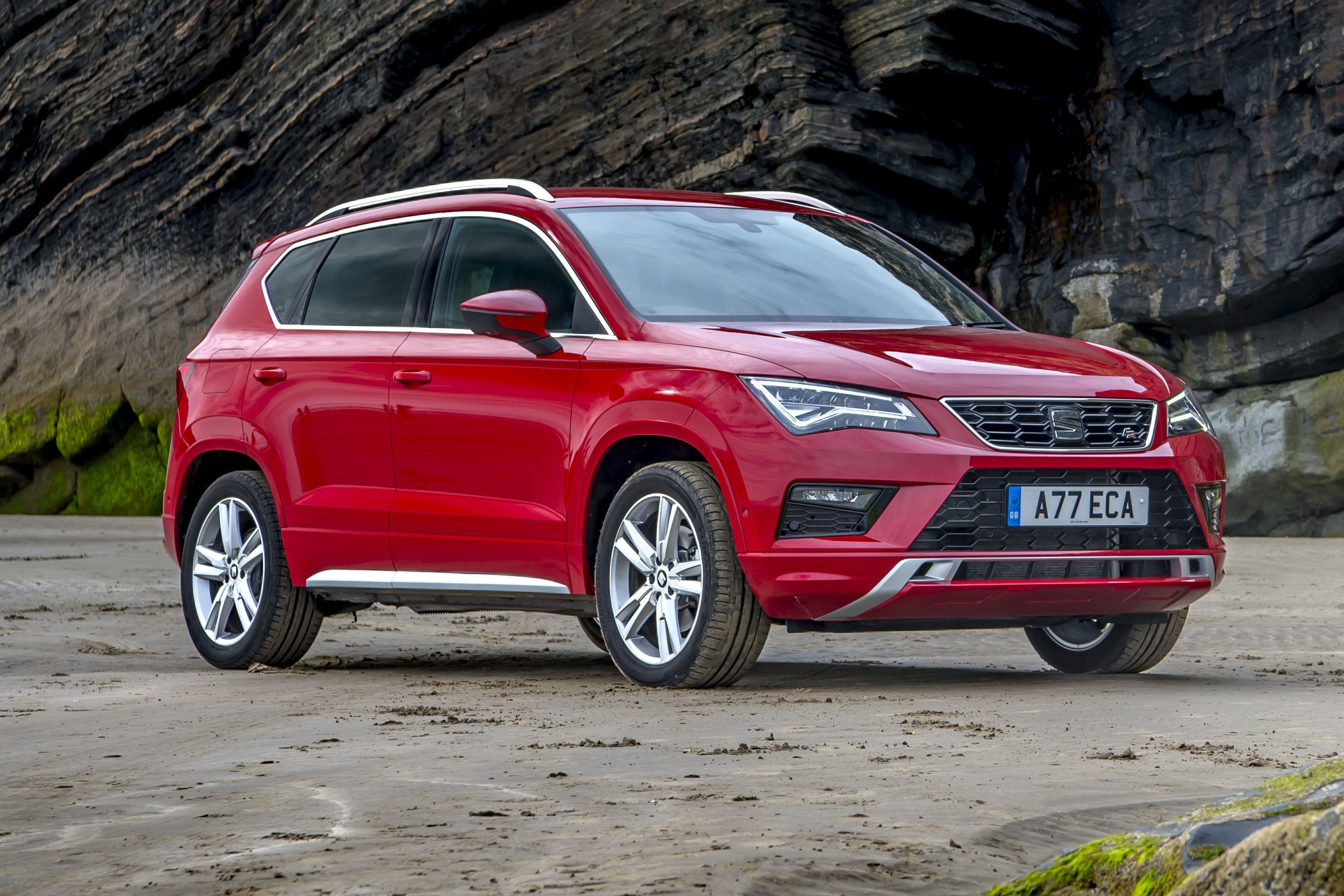Toyota C-HR Review 2024
Written by Rob Clymo
Quick overview
Pros
- Cracking exterior design
- Comfortable if confined cockpit
- Decent handling
Cons
- Engines unrefined if pushed
- Rather snug interior layout
- Miserly rear legroom
Overall verdict on the Toyota C-HR
“Toyota sold lots of original C-HRs and hopes to do the same with its second-generation offering. It’s been completely remodelled on the outside, with a striking design that should hit the right note for fans of the original crossover model.”
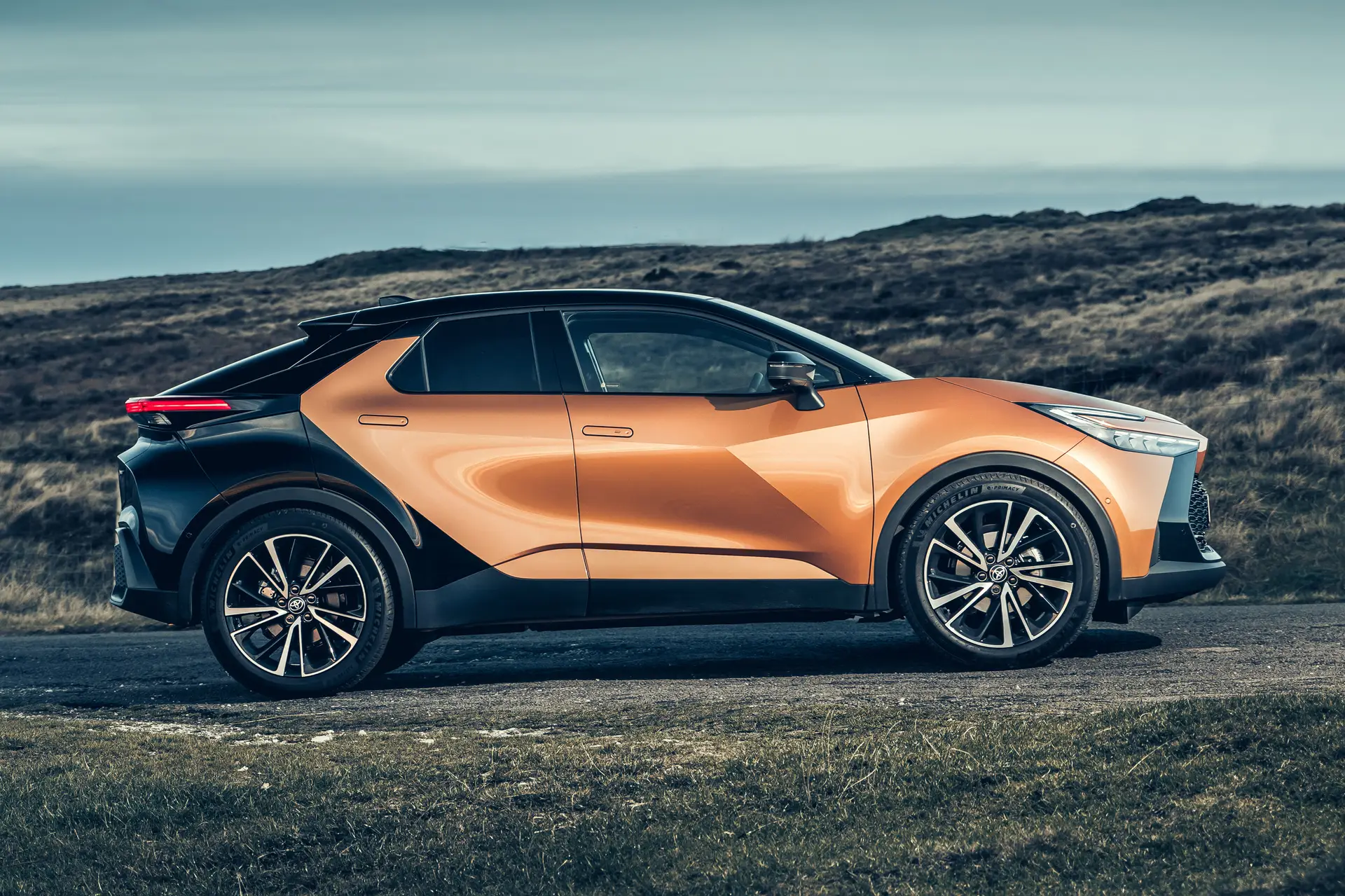
On the outside, there’s a really nice design theme going on with the current crop of Toyota’s and anyone who’s liked the look of the Yaris or Yaris Cross , but wants something a little more substantial should warm to the new C-HR. Is it one of the best small SUVs you can buy? Find out in our Toyota C-HR review.
Lookout for the dramatic bi-tone colourations of the higher-spec cars if you’re keen to make a style statement. Toyota’s designers have made use of improved manufacturing processes to deliver paint-free components, so the striking twin-colour effect offered up on cars with this finish look dramatic to say the least.
This isn’t a big car mind, and the interior reflects that, but it comes with a couple of decent powertrain options, with a plug-in model to follow shortly. However, the revised C-HR features 1.8 or 2-litre hybrid engines are mated to a e-CVT gearbox, a scenario that means you have to nurse it to avoid over animating revving coming from under the bonnet. Nevertheless, either engine – as also fitted to Toyota’s current and less flamboyant Corolla should prove reasonable frugal thanks to having the benefit of a hybrid arrangement. Expect in the region of 60mpg from the 1.8-litre and a smidgen under that for the 2.0-litre model.
Electric assistance from that hybrid setup is fairly low-key it has to be said, with only minimal levels of regenerative braking telling you it’s there at all. However, the soon-come PHEV will be more interesting, with around 40-miles of electric range on the cards. It might be the smarter choice for anyone dealing with those shorter everyday runs.
Either way, the new Toyota C-HR offers up a convincing drive and rewards anyone prepared to put up with those idiosyncrasies delivered by the powertrain with a car that handles surprisingly well. It feels confident through the corners and doesn’t suffer too much in the way of roll, despite the raised stance. That might be down to the slightly wider track and more compact feel of the new car or, indeed, the dedicated chassis tuning that has been going on back at Toyota in order to make this new model a little more taught.
Whatever it is, the revised C-HR is a better car to drive than its predecessor. Considering Toyota has already sold 840,000 units of the original model, it’s easy to see just how much appeal this car will have to existing C-HR converts who already know of its powertrain quirks and compromises on the roominess front.
You’ll need to be a fan to begin with though because the Toyota C-HR isn’t a cheap option and, if you plump for one of the high-spec models, it represents quite a big financial commitment. That’s a bit of a risk for Toyota, especially when buyers for this segment of the market aren’t short on choice. In terms of rivals to tempt you away from the delicious new design lines, there’s plenty of crossover product to choose from, with the likes of the Skoda Karoq, Peugeot 3008, Honda HR-V and hugely popular Nissan Qashqai to consider. However, if you’re keen on making a style statement, there’s no denying the visual charm of the new C-HR, especially if you head for one of those stunning bi-tone cars.
Looking for a used car for sale? We've got 100s of Toyota Approved Used Cars for Sale for you to choose from, including a wide range of Toyota C-HR models for sale. If you're looking for the older version, you need our used Toyota C-HR (2016-2022) review.
Is the Toyota C-HR right for you?
The original incarnation of the Toyota C-HR saw healthy sales notched up across the UK and Europe. The second edition of the small SUV has the potential to do the same, although it has some shortcomings.
The snug front part of the cockpit might not suit larger frames unless the seat is pushed back as far as it can go. Even then, the front seat area is narrow on both sides. Things are just as compact in the back too, which means the latest Toyota C-HR will work for families with smaller children, but anyone with kids approaching their teens might find it all a bit of a squeeze. The theme continues when it comes to boot space.
What’s the best Toyota C-HR model/engine to choose?
You can buy the Toyota C-HR in one of four different model grades; Icon, Design, Excel and GR editions along with a top-specification Premiere Edition, which is only available in limited numbers. However, all cars come with respectable levels of comfort and refinement. It’s worth noting though that the entry-level Icon, Design and Excel feature a 1.8-litre hybrid powertrain, so if you want something a little more potent, you’ll have to spend more too in order to get the 2-litre engine found in the GR and Premiere Edition cars.
Looking more closely at those engines, the Toyota C-HR comes with petrol hybrid powertrain options in the shape of a 138bhp, 1.8-litre, which delivers 136lb ft of torque, closely followed by the 2.0-litre unit that boasts 195bhp and offers up 152lb ft of torque. To be honest, it doesn’t feel like there’s a whole lot to differentiate the two, although after side-by-side drives the 2.0-litre engine felt, to us at least, a little bit smoother when it came to delivering the power.
Unfortunately, because you can only get the bigger engine in the high-spec cars, the extra power provided by the 2.0-litre model might prove to be a non-starter for some if cost is a key concern. Therefore, we’d say head for the 1.8-litre if you’re keen to squeeze slightly better economy figures from your purchase, or the PHEV, which when it arrives might work best of all if short, around town hops and school runs make up your core journeys.
What other cars are similar to the Toyota C-HR?
There are plenty of crossover rivals to tempt you away from the C-HR, including the likes of the Skoda Karoq, Peugeot 3008, Honda HR-V and hugely popular Nissan Qashqai. However, if you’re keen on making a style statement there’s no denying the visual charm of the new Toyota C-HR, especially if you plump for one of the bi-tone cars with their contrasting roofs.
Comfort and design: Toyota C-HR interior
"While making the exterior lines of the C-HR much more interesting, Toyota’s designers have also done their best to transform the interior. It feels fresh, dark and quite moody with lots of black plastic and seat coverings to match. "
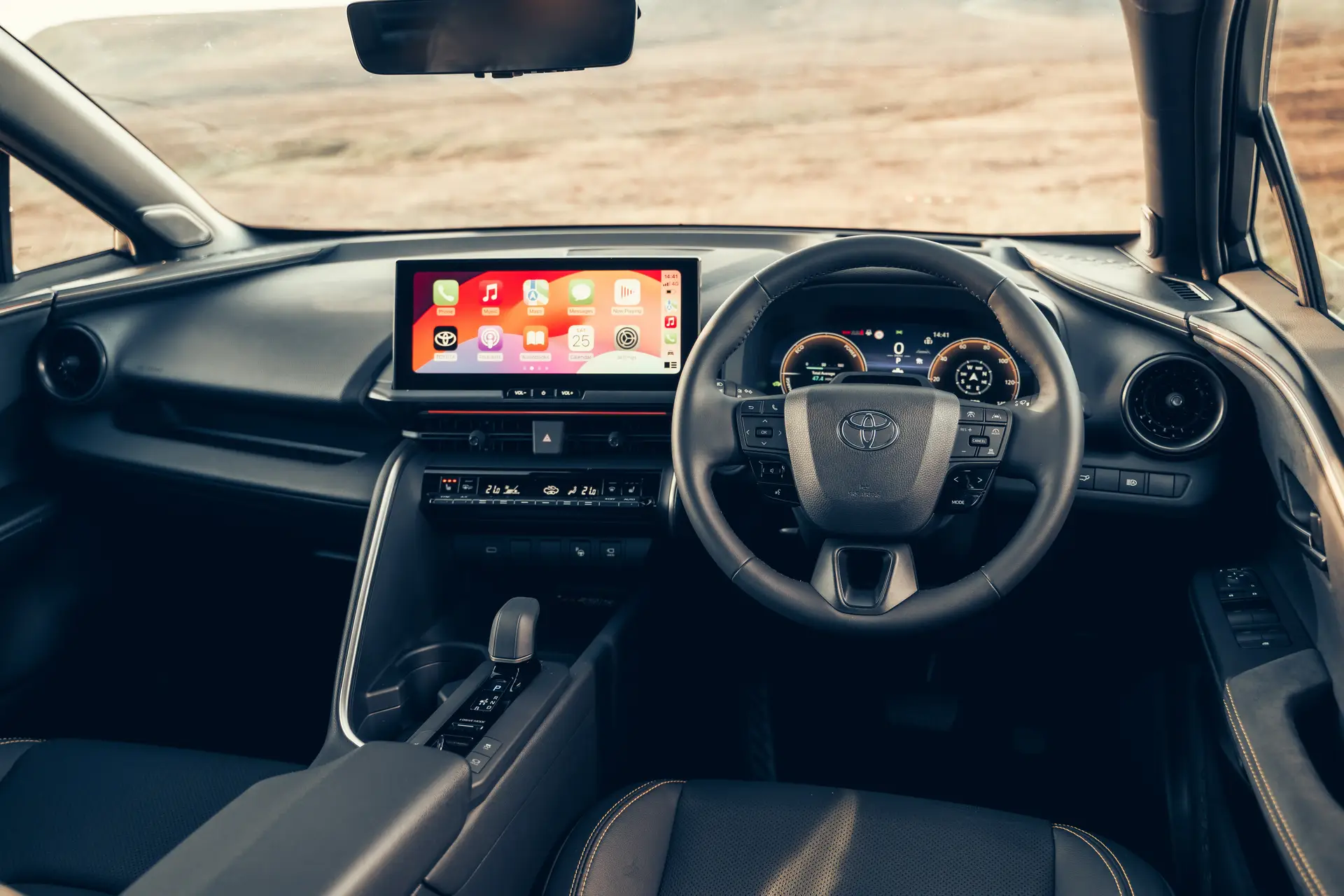
The dashboard line curves around and descends down into the door panels, with leading edges spiced up by ambient lighting. This, incidentally, transitions as you go through the day, so colours change from dawn through to dusk. The front seats feel a little hemmed in by all this creativity though, with the central console a little intrusive for longer-legged types especially on the passenger side. Drop the glovebox and it lands on your knees if you don’t have the seat all the way back.
Try the back seats and you’ll get the same decent levels of comfort, with seat coverings that use material fashioned from recycled PET bottles no less. However, while smaller children will probably find the rear seating area fine, it’s quite cramped if you’ve got adults in the front with their seats pushed back. This was an issue with the first incarnation of the C-HR and, in most ways, it’s much the same this time out, save for better levels of headroom.
Quality and finish
Overall, the quality and finish of the Toyota C-HR is everything you’d expect from the brand. This is particularly noticeable inside and there’s a nice attention to detail with design features like the wraparound dashboard and a good mix of seat covering and door panel materials.
The overall feel is one of quality, which is reflected in the high-ish asking price. This is boosted even more as you head up the trim range, with top-end models boasting special trim treatments that help make them stand out from the crowd.
Infotainment: Touchscreen, USB, nav and stereo in the Toyota C-HR
The standard edition of the Toyota C-HR comes with a eight-inch touchscreen infotainment system, while the more expensive models get the benefit of the 12.3-inch Toyota Smart Connect+ setup.
The Icon grade car comes with a seven-inch digital driver’s instrument display and Toyota’s Smart Connect multimedia system with eight-inch touchscreen. Convenience details include smart entry, an auto-dimming rear-view mirror and automatic wipers, as well as cloud-based navigation, wireless smartphone integration with Apple CarPlay/Android Auto and a front USB-C device charging port. Safety and assistance features include the latest, third-generation Toyota Safety Sense with functions including Pre-Crash System, Adaptive Cruise Control, Lane Trace Assist, Road Sign Assist and Automatic High Beam. There’s a blind-spot monitor that also links to Safe Exit Assist.
The Design grade adds the 12.3-inch customisable driver’s instrument display, 12.3-inch Toyota Smart Connect+ with navigation, front and rear USB-C ports and a wireless phone charger. Meanwhile, the Excel adds ambient interior lighting with 64 colour settings and a panoramic roof. There’s a Panoramic View Monitor that uses a 360-degree camera and the Toyota Safety Sense package is extended with Lane Change Assist, Front Cross Traffic Alert and Adaptive High-beam System headlights. Cornering lights and a driver monitor camera top it off, while the options list includes a premium JBL audio system and a Tech Pack comprising a digital key, head-up display and digital rear-view mirror.
The GR grade gets you a head-up display and JBL audio while the Premium Pack includes a panoramic roof, digital key, digital rear-view mirror, cornering lights and Adaptive High-beam System. This can be boosted with a Safety Pack that adds a driver-monitor camera, Adaptive High-beam System with automatic levelling, cornering lights, Lane Change Assist, Panoramic View Monitor and Front Cross Traffic Alert.
Space and practicality: Toyota C-HR boot space
While the design of the Toyota C-HR has always been about turning heads, the space and practicality levels are compromised as a result. This is most noticeable towards the rear of the car, with headroom inside improved slightly thanks to the addition of a panoramic glass sunroof. But the back seats feel as compromised as ever, with less-than-generous levels of legroom and the angled tail-end of the design making it look and feel quite cramped.
Boot space is also compromised. Official figures are yet to appear from Toyota, but be warned that the PHEV edition of the C-HR could provide even less boot space than the standard car
Handling and ride quality: What's the Toyota C-HR like to drive?
"Settle down inside the cosy cockpit of the Toyota C-HR and you get the impression that this is a car that could be lots of fun to drive. The reality is a little more pedestrian."
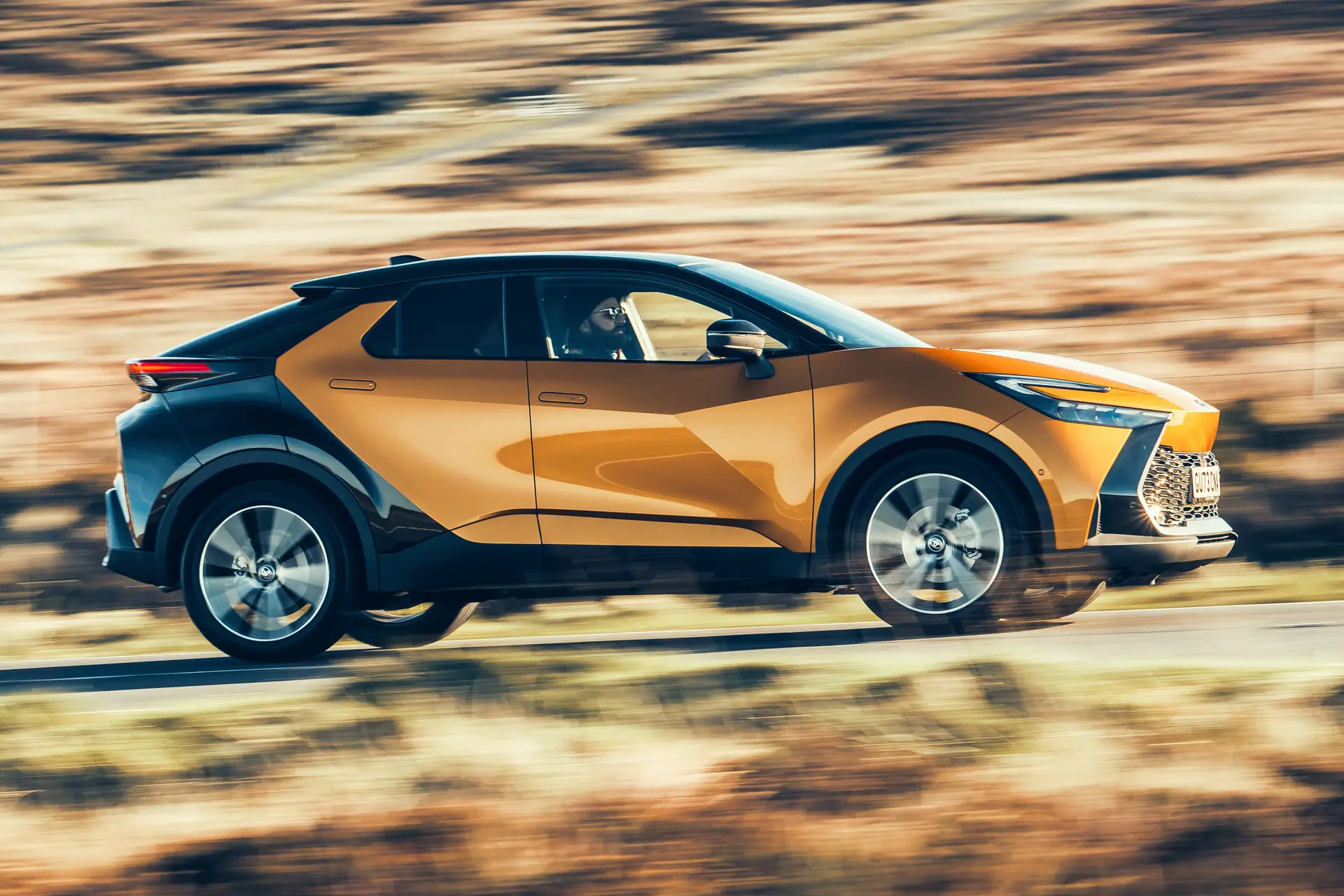
Both the 1.8- or 2.0-litre engines deliver the goods in terms of power, but it arrives in a rather unrefined way with too much revving going on if you dare push the accelerator pedal too far, too soon. There seems to be a slightly strange notch midway through the accelerator travel on our test cars, too.
Trying not to get the engine too excited soon becomes a bit of a preoccupation and takes an edge off the enjoyment. Drive is quickly and easily engaged via a cool little selector on the transmission tunnel while modes are toggled via a nondescript paddle switch just behind. There’s a Sport mode too, but the difference isn’t that noticeable; most owners might be just as happy with the default mode. There’s a degree of brake regeneration and although it’s quite understated, it’s good fun to employ if you’re a keen member of the one-pedal driving fraternity.
Toyota’s engineers have done a sterling job with the suspension setup of the new C-HR. Get the car on an interesting stretch of road and it’s possible to push it quite hard. There’s precious little roll, especially considering this isn’t a low-slung sports car and the driving position feels quite lofty. However, the suspension inspires plenty of confidence when you’re working the C-HR through corners. Hit the motorway and it returns to relatively mundane highway cruiser mode, which isn’t a negative as such – it just gets the job done, no more, no less.
What engines and gearboxes are available in the Toyota C-HR?
The Toyota C-HR features a hat-trick of power options including 1.8- and 2.0 litre full-hybrid variants and a 2.0-litre plug-in hybrid, which will appear early in 2024. The 1.8 hybrid system produces a total output of 140PS. Meanwhile, the 2.0-litre hybrid has a slightly higher output of 197PS.
Both full hybrids suffer from the same harsh revving that comes from pushing them to any degree. If you’ve got a deft control of your right foot the excitement from the hybrid engine and e-CVT box can be tamed, but it requires practice and patience. If, on the other hand, you lose your temper with the Toyota C-HR in either guise it soon gets very animated indeed. Around town, when there’s less chance to go faster, it’s absolutely fine, which should make even more sense once the PHEV edition arrives.
Refinement and noise levels
The Toyota C-HR looks great from the outside but open those doors and the interior looks just as plush. It’s nicely put together too and once you’ve hit the road the overall impression is one of cosseted calm.
No matter what trim level you’ve plumped for, the soundproofing is effective, and the road noise is kept to a minimum. In fact, the only audible factor that spoils the calm somewhat is the enthusiastic revving that comes from either hybrid powertrain when pushed. This, working in tandem with the e-CVT transmission, means the result isn’t quite as hushed as it could be.
Safety equipment: How safe is the Toyota C-HR?
The latest Toyota C-HR hasn't yet been tested by safety organisation Euro NCAP.
It comes with a raft of the latest safety assistance systems, all from within Toyota’s Safety Sense package. This means drivers get the benefit of adaptive cruise control, pedestrian detection, lane-departure warning and automatic high-beam assistance along with road-sign recognition and autonomous emergency braking.
MPG fuel costs: What does the Toyota C-HR cost to run?
"The original Toyota C-HR delivered respectable economy and the trend looks set to continue with the second-generation car."
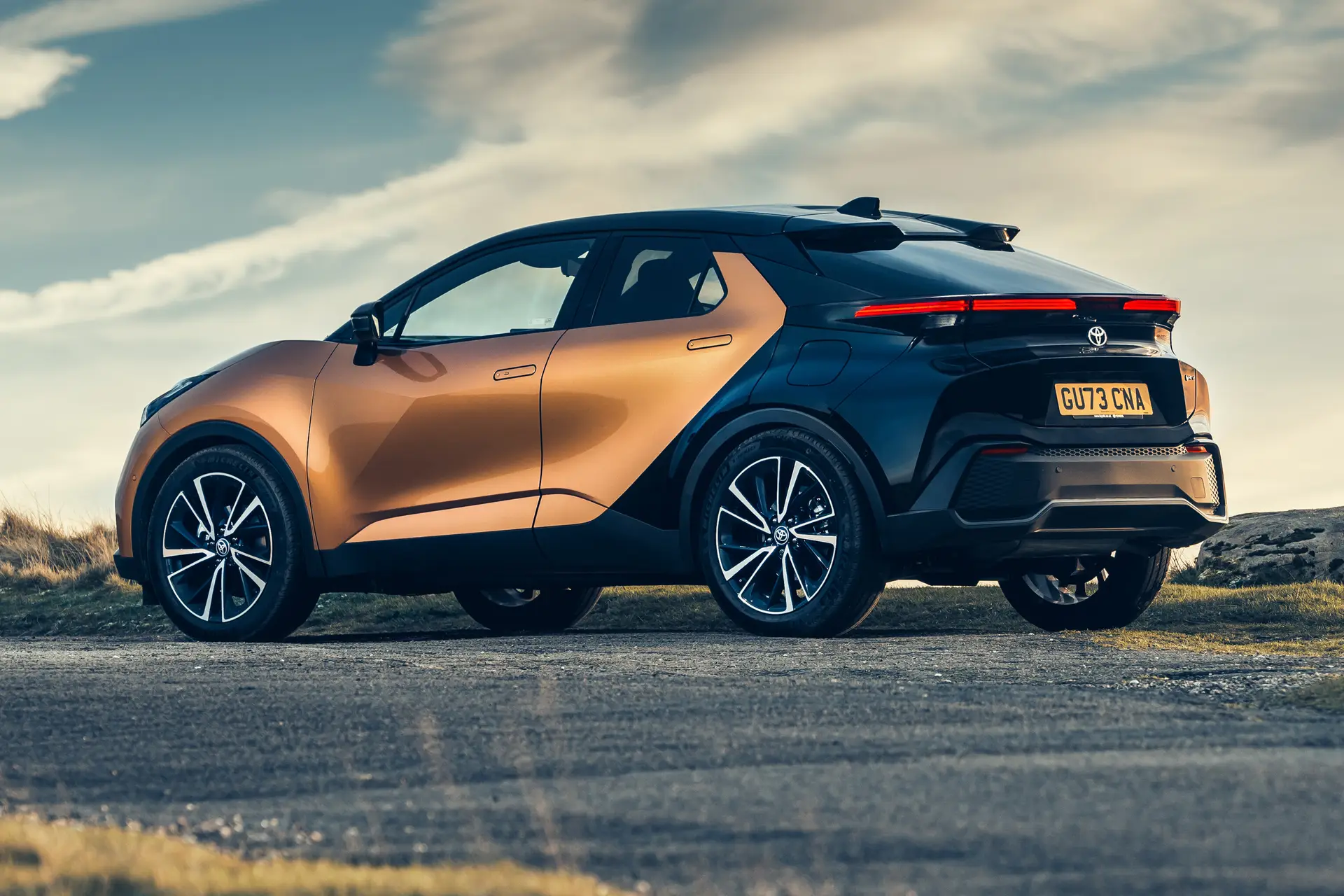
Although the 1.8 and 2.0-litre engines might seem quite large for the size of the car, especially compared to rivals, owners can expect to get an impressive official figure of 60.1mpg for the 1.8-litre while the 2.0-litre engine is slightly lower at 57.7mpg. Either way, both powertrains should be reasonably economical to run.
How reliable is the Toyota C-HR?
Toyota has a solid reputation for reliability and while the newest incarnation of the C-HR has yet to hit the road, it seems likely that the car will continue that theme.
Insurance groups and costs
The new Toyota C-HR’s insurance groups have yet to be confirmed.
VED car tax: What is the annual road tax on a Toyota C-HR?
As a hybrid, the Toyota C-HR will be subject to the same flat rate of Vehicle Excise Duty as other alternative-fuel cars, which is £170 per year from the second year of taxation. Models costing more than £40,000 when new will also attract a surcharge of £390. The first-year tax rates haven’t been confirmed at the time of writing.
How much should you be paying for a used Toyota C-HR?
"The second-generation Toyota C-HR is a brand-new model, which starts out at £31,290 for the 1.8 hybrid engine Icon model grade. "
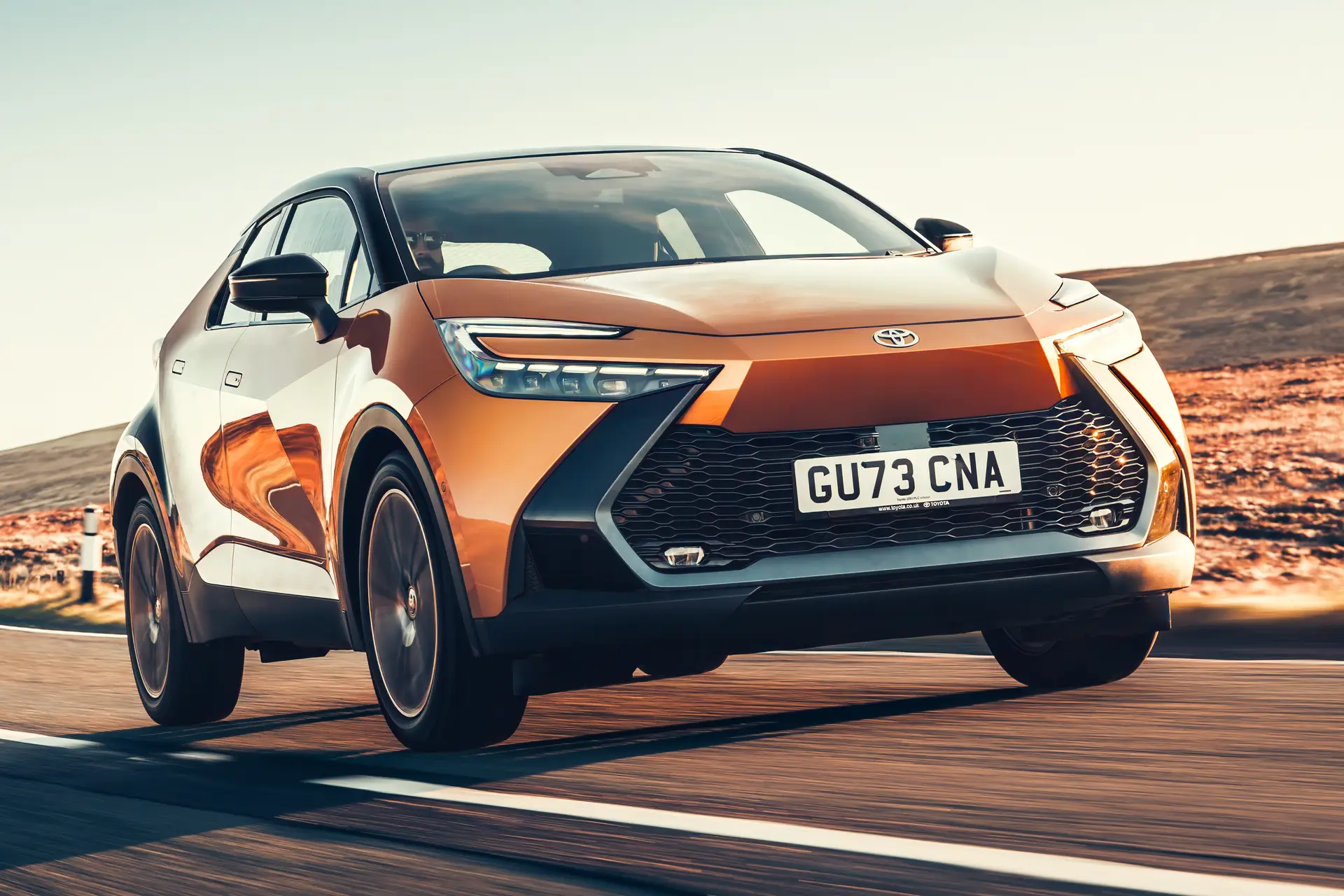
The Design grade car with the same 1.8 hybrid engine is priced at £34,685 while the Excel edition fitted with the same powertrain costs £38,150. The 2.0-litre hybrid Toyota C-HR Sport has a price tag of £40,645 and the range-topping 2.0-litre hybrid Premier Edition is priced at £42,720.
Pricing for the Toyota C-HR plug-in hybrid is due to be announced for release early in 2024.
Trim levels and standard equipment
The Toyota C-HR is available in Icon, Design, Excel and GR Sport versions, supplemented with a limited Premiere Edition. Icon grade models come with 17-inch alloy wheels, flush door handles, powered folding door mirrors and a natty signature Toyota C-HR rear light bar. The cockpit features cloth upholstery, a seven-inch digital instrument display supplemented by Toyota’s Smart Connect multimedia system inside an eight-inch touchscreen. Icon models also get smart entry, an auto-dimming rear-view mirror, automatic wipers and cloud-based navigation.
There’s also wireless smartphone integration with Apple CarPlay and Android Auto along with a front USB-C device charging port. Driver safety and assistance comes in the shape of Toyota’s third-gen Safety Sense, which includes Pre-Crash System, Adaptive Cruise Control, Lane Trace Assist, Road Sign Assist and Automatic High Beam.
The Toyota C-HR Icon grade features 18-inch alloy wheels, rear privacy glass, a power tailgate and parking sensors with an automatic brake function. Inside the cockpit, there are heated front seats and individual climate control. You also get the benefit of a larger 12.3-inch driver’s display along with a 12.3-inch infotainment screen packing the Toyota Smart Connect+ system that includes navigation. Wireless charging along with front and rear USB-C charge points also feature. However, it is also possible to add a Skyview fixed panoramic roof with thermal glass along with a bi-tone paint finish as options.
Move on up to the Excel edition of the Toyota C-HR and it comes with 19-inch machined alloy wheels, bi-tone paintwork, sportier front seats finished in a plush suede effect covering along with ambient lighting that offers a range of 64-different colour settings for the interior. There’s a panoramic glass roof along with a 360-degree camera system and a full suite of driver aids via Toyota’s Safety Sense package, which includes the likes of Lane Change Assist, Front Cross Traffic Alert and adaptive main beam headlights. Additional options include a JBL audio system and Tech Pack that comprises a digital key, head-up display and digital rear-view mirror.
The Toyota C-HR GR Sport grade takes the interior quality up a notch or two, with additional styling touches based on the Toyota Gazoo Racing theme. Wheels are upgraded to 10-inch GR Sport alloys plus there’s a head-up display and an audio system from JBL. The Premium Pack add-on includes a panoramic glass roof, Panoramic View Monitor and Front Cross Traffic Alert. Finally, the Premiere Edition delivers everything the Excel grade offers along with leather seats, bi-tone exterior and cool colour combination tweaks.
Ask the heycar experts: common questions
Where does the C-HR fit in Toyota's range?
How much does a new Toyota C-HR cost?
Is the Toyota C-HR electric?
Stay up to speed with great offers plus the latest car news and reviews
Keep me updated by email with the latest advice, news and offers from heycar.
By submitting you agree to our privacy policy

